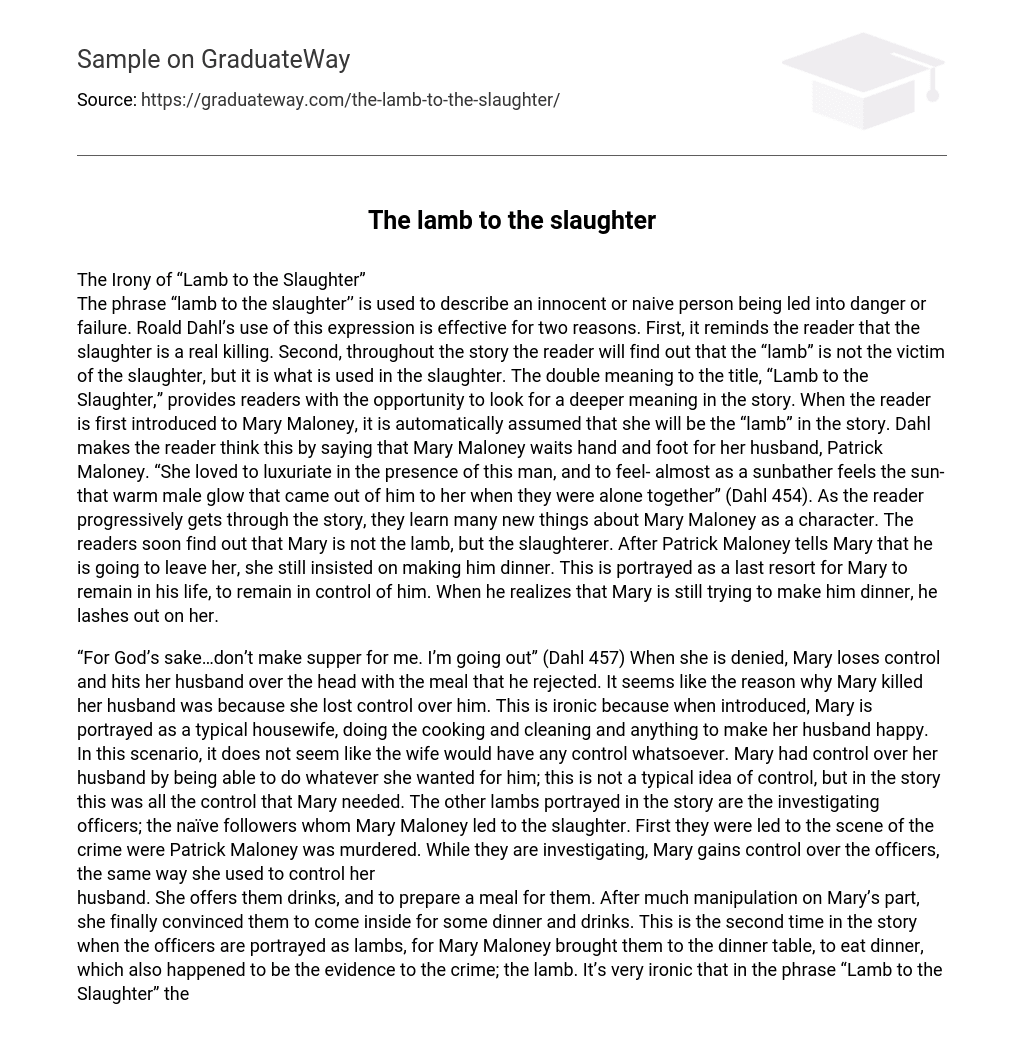The Irony of “Lamb to the Slaughter”
The phrase “lamb to the slaughter’’ is used to describe an innocent or naive person being led into danger or failure. Roald Dahl’s use of this expression is effective for two reasons. First, it reminds the reader that the slaughter is a real killing. Second, throughout the story the reader will find out that the “lamb” is not the victim of the slaughter, but it is what is used in the slaughter. The double meaning to the title, “Lamb to the Slaughter,” provides readers with the opportunity to look for a deeper meaning in the story. When the reader is first introduced to Mary Maloney, it is automatically assumed that she will be the “lamb” in the story. Dahl makes the reader think this by saying that Mary Maloney waits hand and foot for her husband, Patrick Maloney. “She loved to luxuriate in the presence of this man, and to feel- almost as a sunbather feels the sun- that warm male glow that came out of him to her when they were alone together” (Dahl 454). As the reader progressively gets through the story, they learn many new things about Mary Maloney as a character. The readers soon find out that Mary is not the lamb, but the slaughterer. After Patrick Maloney tells Mary that he is going to leave her, she still insisted on making him dinner. This is portrayed as a last resort for Mary to remain in his life, to remain in control of him. When he realizes that Mary is still trying to make him dinner, he lashes out on her.
“For God’s sake…don’t make supper for me. I’m going out” (Dahl 457) When she is denied, Mary loses control and hits her husband over the head with the meal that he rejected. It seems like the reason why Mary killed her husband was because she lost control over him. This is ironic because when introduced, Mary is portrayed as a typical housewife, doing the cooking and cleaning and anything to make her husband happy. In this scenario, it does not seem like the wife would have any control whatsoever. Mary had control over her husband by being able to do whatever she wanted for him; this is not a typical idea of control, but in the story this was all the control that Mary needed. The other lambs portrayed in the story are the investigating officers; the naïve followers whom Mary Maloney led to the slaughter. First they were led to the scene of the crime were Patrick Maloney was murdered. While they are investigating, Mary gains control over the officers, the same way she used to control her
husband. She offers them drinks, and to prepare a meal for them. After much manipulation on Mary’s part, she finally convinced them to come inside for some dinner and drinks. This is the second time in the story when the officers are portrayed as lambs, for Mary Maloney brought them to the dinner table, to eat dinner, which also happened to be the evidence to the crime; the lamb. It’s very ironic that in the phrase “Lamb to the Slaughter” the lamb is the one who gets led into some sort of trouble. In this case, a lamb literally does the slaughtering. It does not even cross the officer’s minds that they are about to eat the only evidence to the crime tying Mary to the killing of her husband. Mary got the officers or the “lambs” to do exactly what she wanted, thus gaining the control she needs over them. The The last time readers see Mary Maloney, she is in another room laughing to herself, for the officers makes a claim that he thinks that the murder weapon is “right here on the premises.” Another jokes, “probably right here under our very noses” (Dahl 462). As it is easily found out, Mary Maloney is not the lamb that Dahl tries to convince the readers she is. If re-read, readers are introduced to some disturbing observations about Mary’s character and her relationship with her husband. Since throughout the first time reading, the readers are biased to think that Mary is the poor, innocent lamb, her actions and composure throughout that evening go easily unnoticed. For example, there a suggestions quite a few times during the story that maybe Mary had planned on murdering her husband all along. Once her husband denies her making dinner for him, readers are left with many questions about Mary’s upcoming actions. At what point does Mary actually decide to use the meal first metaphorically and then as a weapon? If she really had no intentions of murdering her husband, why would she unwrap and inspect all the meat in the cellar? Also, why does she hold it as if it were an actual weapon rather than a piece of meat, ‘‘holding the thin bone end of it with both hands’’? (Dahl 457) These examples lead the readers to believe that Mary exemplified characteristics of a murderer rather than a lamb all along. Dahl uses the irony in the story to the show the readers that what is initially thought about someone is not always true. Mary Maloney who is introduced as an innocent housewife turns out to be a murderer. Dahl is teaching the readers a lesson that there is more to a person than what meets the eye; carefully observing ones actions can introduce much more about a person. The end of
the story draws the ultimate conclusion that as long as there are lambs (people willing to be manipulated), there will be slaughters.
Works Cited
Dahl, Roald. Lamb to the Slaughter: And Other Stories. London: Penguin, 1995.
Print.





